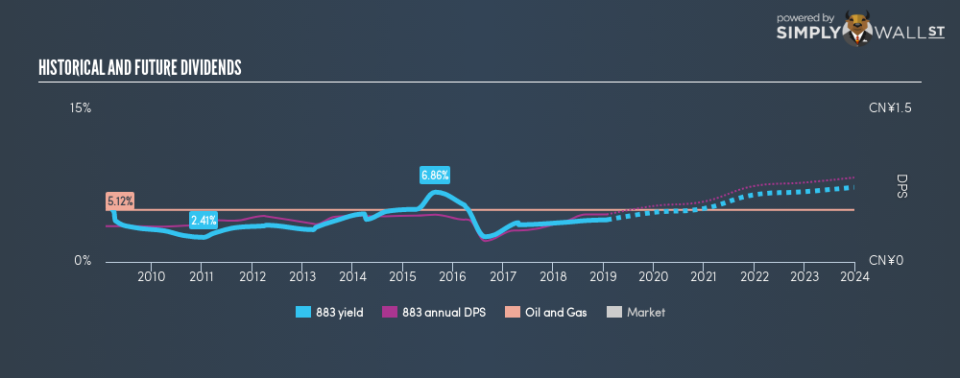Should CNOOC Limited (HKG:883) Be Part Of Your Dividend Portfolio?

A large part of investment returns can be generated by dividend-paying stock given their role in compounding returns over time. Historically, CNOOC Limited (HKG:883) has been paying a dividend to shareholders. Today it yields 4.1%. Let’s dig deeper into whether CNOOC should have a place in your portfolio.
Check out our latest analysis for CNOOC
5 questions to ask before buying a dividend stock
If you are a dividend investor, you should always assess these five key metrics:
Is their annual yield among the top 25% of dividend payers?
Does it consistently pay out dividends without missing a payment of significantly cutting payout?
Has it increased its dividend per share amount over the past?
Does earnings amply cover its dividend payments?
Based on future earnings growth, will it be able to continue to payout dividend at the current rate?
Does CNOOC pass our checks?
The company currently pays out 65% of its earnings as a dividend, according to its trailing twelve-month data, meaning the dividend is sufficiently covered by earnings. In the near future, analysts are predicting lower payout ratio of 49% which, assuming the share price stays the same, leads to a dividend yield of 5.2%. However, EPS should increase to CN¥1.21, meaning that the lower payout ratio does not necessarily implicate a lower dividend payment.
When assessing the forecast sustainability of a dividend it is also worth considering the cash flow of the business. A business with strong cash flow can sustain a higher divided payout ratio than a company with weak cash flow.
If there is one thing that you want to be reliable in your life, it’s dividend stocks and their constant income stream. Whilst its per-share payments have increased during the past 10 years, there has been some hiccups. Investors have seen reductions in the dividend per share in the past, although, it has picked up again.
Relative to peers, CNOOC produces a yield of 4.1%, which is on the low-side for Oil and Gas stocks.
Next Steps:
Keeping in mind the dividend characteristics above, CNOOC is definitely worth considering for investors looking to build a dedicated income portfolio. Given that this is purely a dividend analysis, you should always research extensively before deciding whether or not a stock is an appropriate investment for you. I always recommend analysing the company’s fundamentals and underlying business before making an investment decision. Below, I’ve compiled three essential aspects you should look at:
Future Outlook: What are well-informed industry analysts predicting for 883’s future growth? Take a look at our free research report of analyst consensus for 883’s outlook.
Valuation: What is 883 worth today? Even if the stock is a cash cow, it’s not worth an infinite price. The intrinsic value infographic in our free research report helps visualize whether 883 is currently mispriced by the market.
Other Dividend Rockstars: Are there better dividend payers with stronger fundamentals out there? Check out our free list of these great stocks here.
To help readers see past the short term volatility of the financial market, we aim to bring you a long-term focused research analysis purely driven by fundamental data. Note that our analysis does not factor in the latest price-sensitive company announcements.
The author is an independent contributor and at the time of publication had no position in the stocks mentioned. For errors that warrant correction please contact the editor at editorial-team@simplywallst.com.

 Yahoo Finance
Yahoo Finance 
